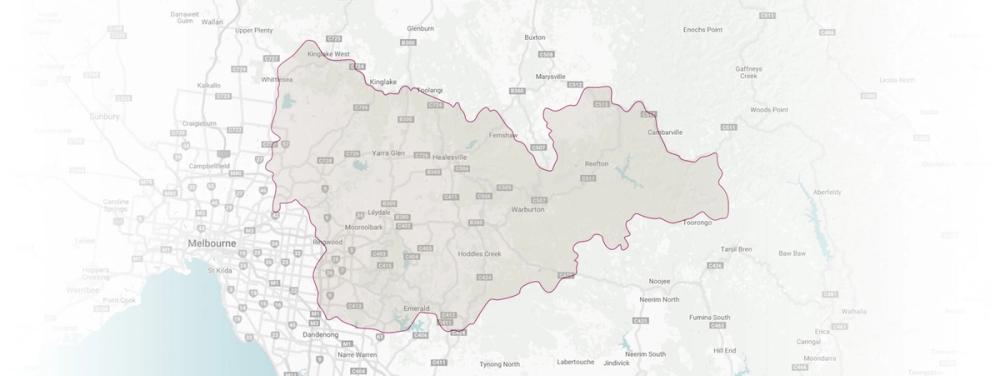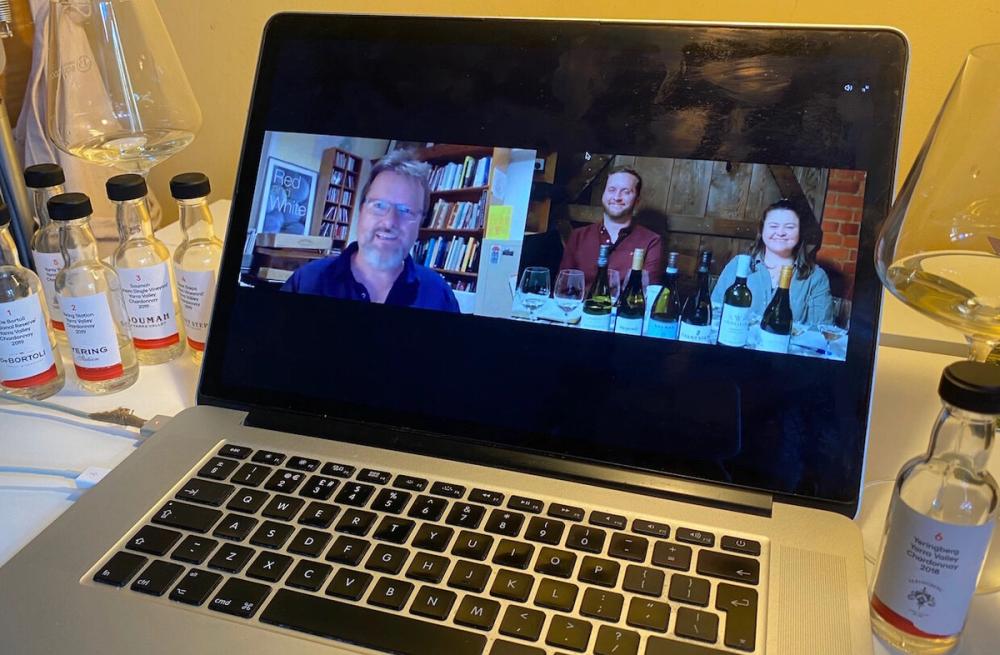Contemporary Yarra Valley Chardonnay is finding a nice balance between some sites that show that version of restraint with lovely purity and others that are plusher but still elegant and fresh.
“I can do you a great deal on crayfish, now we’re not sending any to China. Oh no I only mentioned the ‘C word’ I shouldn’t have done that I’m sorry.”
Wine and drinks writer Max Allen, the compere for Ancient Soils – Contemporary Wines: Yarra Valley Chardonnay, ran the morning virtual tasting and webinar with his customary mix of wit and wisdom. The six wines were showing very well and the two winemakers showed up – which is saying something when you saw the damage wreaked by Victoria’s storms the night before and which delayed proceedings on Wine Australia’s new Connect platform by 24 hours.
Sarah Crowe, winemaker for Yarra Yering and Brendan Hawker, winemaker for Yering Station, were sat in the back of a café near Melbourne, which was the nearest spot to the Yarra Valley where they could access Wi-Fi, the wine region still knocked out by falling trees.

Yarra Yarra Chardonnay tasting 11 June, 2021 – the new Wine Australia Connect platform working well
Understanding the Yarra Valley
Yarra Valley is not prone to storms of such Biblical ferocity in fact its docility is one of the reasons grapes were planted here 170 years ago – largely Chardonnay, Pinot Noir, Cabernet Sauvignon and Shiraz, and increasingly the whole gamut of more idiosyncratic international varieties including the likes of Savagnin and Arneis.
One of Australia’s coolest wine regions, the Yarra Valley runs alongside the Yarra River, east of Melbourne, flanked to the North by the Great Dividing Range and to the south by the Dandenong Range. It is the Great Dividing Range that is a significant factor to vine health with the main soil type – grey-brown sandy loam with a mix of rocky clay sub-soil – that is contrasted by younger, red, volcanic-derived soils.

It is this mix of ancient soils and varying altitudes that allows Chardonnay to take many styles fashioned, of course, by the age of the vines, whether they are dry-farmed or not, and then the approach of the winemaker and estate, of which there are about 80 accounting for 2,536 hectares.
Four of the six wines at the tasting were from 2019 – a hot vintage – although you couldn’t tell that from the wines, none of which were showing over-ripeness or alcohol above 13.5% abv. Although the styles of the individual wines did vary (see notes below) they were all generally bright, clean, smartly made and with a purity that was light years away from Chardonnays of 20-30 years ago which “Had more oak, more fruit ripeness, more of everything,” as Crowe put it.
Although stylistically winemakers turned the dial too far towards the austerity side of things, there now seems to be a happy balance in today’s wines and a decent intuition from the winemakers on when to pick, whether to use cultured or indigenous yeast, oak treatment, single site or a blend of vineyards and so on.
Picking is happening on average two weeks earlier than 50 years ago, said Crowe but for her she pays closest attention to the acidity “I’m not looking for sugar-ripeness – I’m getting fruit ripeness – but so long as the green acid has dropped out you’re good to go,” she says.
Both Crowe and Hawker referenced the Mendoza clone, which was widely planted in the 1990s when the industry expanded rapidly, and in particular the shape of the bunches which have a mix of large and small berries.
“With the Mendoza clone you get large berries that have flavour and tannin ripeness and smaller berries that give you that little whip of acidity which contrasts with the stone fruit character, for example,” sais Hawker.
Two of the wineries we are sampling from Soumah and Giant Steps are good examples of this in that both were largely planted with Mendoza, both in 1997, at the peak of the expansion.

What instigated the change of style?
So the question was asked. Was there a particular catalyst that kick-started this move a decade ago to a lightening of the Australia Chardonnay style? Was it the influence of Oakridge 864 which paved the way towards a more savoury, earlier picked, mineral style of Chardonnay?
“It was probably a reaction to the market, a disinterest and a shifting away from that style – not that people were necessarily grasping out for a leaner style of Chardonnay,” says Hawker, “it was probably at the time when Marlborough Sauv Blanc was becoming a bit more prevalent and people were looking for something a little bit cleaner and fresher than the oaky and buttery – it was that whole generation of people they called the ABCs – Anything But Chardonnays, and the pendulum swung quite heavily in the other direction to this very austere, lean style of Chardonnay, I think contemporary Yarra Valley Chardonnay is finding a nice balance between some sites that show that version of restraint – with lovely purity – and others that are plusher but still elegant and fresh.”
Crowe believes the change also happened because winemakers themselves wanted to express terroir more.
“I think Oakridge and David Bicknell took that style to the country and it has filtered out to the world largely through the Australian wine show system as well,” says Crowe, “but I think it has dovetailed really nicely with a shift by us as Australian winemakers wanting to make wines that represent our land, and our country; so a big focus on single vineyard wines happened at the same time and wanting to have a greater depth of understanding of the grapes and sites we’re working with. It’s not quite that simple but Oakridge 864 did play a significant role,” she says.
Max Allen controversially went on to talk about collusion between wine critics and producers – a ‘closed circle’ of wine judges and producers who create a ‘positive feedback loop’ for themselves and heavily influence winemaking styles.
“There is and has been for many decades a very cosy relationship between the people who are judging the wine shows and those who are making the wine, very often they’re the same people,” Allen says. “So if all those jusdges sit around at the end of a wine show and all enjoy a certain style of Chablis, let’s say, and ask why can’t we make a style of wine that’s a little bit more like this? – still very Australian still full of flavour and sunshine but a bit more restrained. Then they make a wine like that and then their friends who all agree with that winemaker who all judge at the same wine show give that wine the trophy then they’ve created that positive feedback loop for themselves that results in style shifts in Australia.”
“We saw that in the 1980s with cooler climate Cabernets, very low in alcohol with very green flavours. That very austere style of Chardonnay was all the rage for a while and now we’ve swung back into a middle ground where we have lightness and delicacy, finesse and detail, but not lacking in flavour and not lacking in concentration and flow.”
And so onto tasting the Yarra Valley Chardonnays themselves

All prices are retail including VAT
De Bortoli Regional Reserve Chardonnay 2019
DeBortoli is one of the top 10 largest wine producers in Australia with winemaker Steve Webber credited by Crowe of always evolving and challenging ever since setting up shop in the Yarra in the 1970s. A mix of sites and wood/ steel formats is behind this flavoursome, clean, well balanced Chardonnay that doesn’t put a foot wrong, even if it was the least complex of the range tasted. Floral, orchard fruit, nice texture and zippy energy to the wine. Price-wise this offers incredible value for money. 12.7% abv, £11.99 (North South Wines)
Yering Station Chardonnay 2019
Site of the first vineyard planted in Victoria in 1838, then developed into a premium wine-producing estate in 1996 by the Rathbone family. This is a blend of nine different vineyards using the Mendoza clone, barrel fermented and aged for 10 months in large format French oak (28% new). Winemaker Brendan Hawker avoids malolactic fermentation so there is a decent backbone of acidity with plenty of ripe, flavoursome fruit. There’s a bit more stone fruit, toasty almond, flint and a hugely persistent length. 13.5% abv, £24.99 (Bibendum)
Soumah Single Vineyard Hexham Chardonnay 2019
Soumah’s business model is to use contract winemaking facilities (common for wineries of this size) and focus on the vineyard where this single site Chardonnay is handpicked, whole-bunch pressed and barrel fermented, matured on lees for eight months with partial malo. Of all six wines this had more of the sweet vanilla oak, and a struck match quality to the nose with brioche and savoury notes. On the palate it is tight and flinty, the structure holding the fruitiness together well, through its considerable length on the palate. 13% abv, £19.95 (The Vinorium)
Giant Steps, Sexton Vineyard Chardonnay 2019
All the fruit here is hand-picked, whole bunch pressed, wild ferment in 500 litre French puncheons (20% new), no malo or punchdowns. The style is quite Chablis-esque, savoury, toasty notes on the nose, oyster shell, a bit more muscular in style on the palate, with a clearly defined phenolic and mineral content. Waves of citrus flavour (orange and green), intense, textural and with a real power behind the fruit (in a good not heavy-handed way). 13% abv, £33, (Liberty Wines)
Yarra Yering Chardonnay 2018
2018 had a good fruit-set, yields and high quality juice at Yarra Yering – the grapes being blast-chilled and whole bunch pressed before fermented in a variety of French oak formats (30% new) and matured for 10 months. The deep-rooted dry-grown vines adds greater concentration of flavour and a fine, steel-crisp acidity holds the flavours together. There is a real citrus drive here, lemon pith and fine-grained texture on the long length. Great acidity. 13% abv, £51.90 (Berkmann)
Yeringberg Chardonnay 2018
Fourth generation of the de Pury family are running this pioneering winery hailing back to the 1860s and replanted in the 1969. It’s a National Trust-protected winery so the style is dictated by limitations on size – everything is crushed which gives the wine extra phenolic content. The full malo in the 30% new barrels adds a silky plushness to the wine and a softer acidity. Lovely texture, drive and depth of flavour. A wine with tangy orange citrus, intensity, volume and length. 12.5% abv, £33, (WoodWinters)
In terms of preference I would rate them in order: 6, 5, 2, 1, 4, 3 with the Yeringberg being my favourite.










































